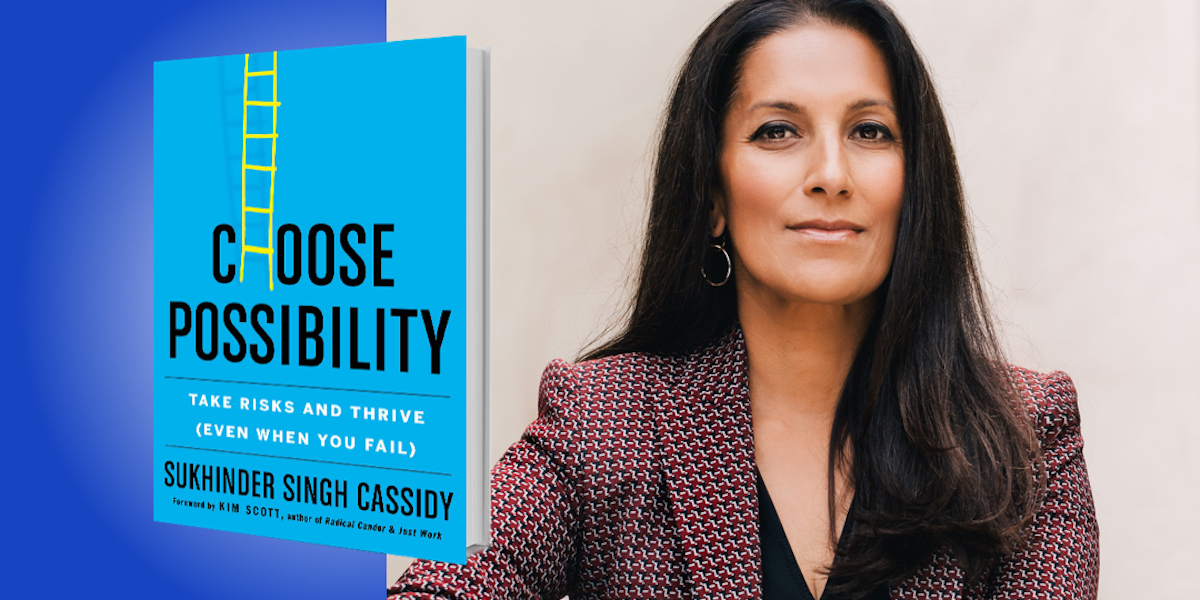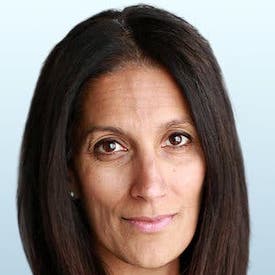Sukhinder Singh Cassidy is a leading technology executive and entrepreneur, board member, and investor with twenty-five years of experience founding and helping to scale companies, including Google and Amazon. Most recently, she served as president of StubHub and as a member of eBay’s executive leadership team. She has been named one of the Most Creative People in Business by Fast Company, and she has been profiled in Fortune, Forbes, the Wall Street Journal, Business Week, and the New York Times.
Below, Sukhinder shares 5 key insights from her new book, Choose Possibility: Take Risks and Thrive (Even When You Fail). Listen to the audio version—read by Sukhinder herself—in the Next Big Idea App.
1. To start taking risks, we must stop subscribing to the “Myth of the Single Choice.”
“Life is either a daring adventure or nothing at all,” Helen Keller once said. While this idea may seem inspiring, it also leaves us all with the impression that taking a risk is about one gigantic, scary leap of faith. While that leap may take us to the top of a mountain, it may also result in disastrous failure from which we will never recover. This leaves the average person stressed and never wanting to leave basecamp.
Everywhere we look, stories of celebrities and moguls shared in the media reinforce a fairy tale version of the Hero’s Journey, and a rather binary view of risk-taking. It’s no wonder so many people subscribe to what I call the “Myth of the Single Choice,” the belief that we are always one gigantic move away from massive success or epic defeat.
But we’re not. In reality, unlocking career rewards often takes multiple moves. Success is correlated with our ability to keep iterating our way through choices, big and small, some that work and some that don’t. If we want to become better risk-takers in our own lives, it’s time to let go of the Myth of the Single Choice and free ourselves from the pressure to make one mighty and perfect move.
“Before we take a big risk to realize an ambition, we have chances to take small risks to discover opportunity.”
2. To build your risk-taking muscles, find reasons to take risks every day.
We’ve been trained to believe that all risk-taking is for glory, to achieve some large ambition. This is one of the reasons we take risks, but there are at least three other reasons to try making new choices in our daily lives.
One of these reasons is to discover new opportunities, to maximize our knowledge of all available choices before choosing by trying things on for size. In the summer following my first year of university, I got a job as a receptionist at the local Filter Queen franchise. There I saw vacuum salesmen open the yellow pages and begin cold calling residents of our hometown, giving pitch after pitch to secure demonstration appointments. They were masters at risk-taking for discovery, using all their efforts to uncover possibility and find new customers. So before we take a big risk to realize an ambition, we have chances to take small risks to discover opportunity.
We also take risks to learn, to master a new skill or capability. These small risks of our time and energy are easy ways to advance our knowledge now and opportunity to have more impact later.
And lastly, we take risks to avoid potential harm or injury. Many people learned this lesson in navigating their businesses and personal lives through the COVID crisis. While we often pause on taking risks when environments are stable, in almost every family, team, and company in the world, people rapidly made choices they never anticipated to make sure they could survive when the whole world shut down. Taking small, daily risks like these helps you build your risk-taking muscles for when you encounter a bigger, tougher choice.
3. Becoming a risk-taker is about managing two fears, not one.
In January 2011, about 18 months after leaving a successful career at Google, but just three months after a painful exit from my first CEO role in an ecommerce startup, I was thinking about my next career choice. I had an idea for founding a new company focused on video commerce, and I feared missing out on the opportunity; in short, my FOMO was raging. But so was my fear of failure—being the CEO of an ecommerce company had already not worked out once, so all I could think was, “What if I fail again?”
“The smartest risk-takers know that finding success is not always just about us, but about the macro environment and trends that may affect our chances for success.”
I was confronting the two fears that any of us face when we contemplate making a new choice. Our fear of missing out wages war with our fear of failure. When our FOMO exceeds our fear of failure, we take action; when our fear of failure exceeds our FOMO, we stay still. Managing both of these fears is key to becoming an adept risk-taker.
In my case, I tried to face my fear of failure head on. I visualized not only the positive outcomes, but also the “failure case” and what choices would be available to me if the idea didn’t work. I concluded that I would learn a tremendous amount about ecommerce, that my résumé was strong enough to go back to the corporate world if I still wanted, and that my ego could withstand not succeeding in the pursuit of something innovative. This is how I shrank my fear of failure enough to act, got the risk equation working in my favor, and started my second company, Joyus.
4. Becoming a better risk-taker is not all about you.
When we take a risk and succeed, people heap praise upon us; when we fail, we heap shame upon ourselves for all the ways in which we’ve faltered. But the smartest risk-takers know that finding success is not always just about us, but about the macro environment and trends that may affect our chances for success.
There are all kinds of important factors in our environment that we can anticipate, like the tailwinds in a division, company, or industry we are considering joining, and even the headwinds in those same environments that give us an opportunity to have greater impact. We don’t need to be an oracle to be a smart risk-taker; we simply need to lift our heads up and identify these factors and how they affect our chances.
“The people we work with every day disproportionately affect the joy, impact, and learning we find in any role.”
For example, in 2011, Microsoft’s then-CEO Steve Ballmer asked Satya Nadella, a company veteran, to take the reins of the Server and Tools business, one of the company’s cash cows. At the time, a group inside the division was pursuing a brand new bet: building a cloud business called Azure. There were many reasons to shy away from supporting it, and there was much consternation internally. But instead of shying away from it, Nadella realized that the cloud business was booming, and that it needed to be part of Microsoft’s future. He leaned hard into the opportunity, and even though it represented a major risk to his reputation, he succeeded nonetheless. As a result, Microsoft lost its sleepy reputation in tech, and in 2014, Nadella was named the company’s new CEO.
5. Being a smart risk-taker means betting on the who even more than the what.
The traditional wisdom around building great careers is about pursuing our passions. There is a lot of good that comes from that, but the problem is, our interests change over time. Our passions may not be able to pay our bills, and we may not find them so joyful when we try to turn them from fun hobbies into full-time work. But what is enduringly true is that the people we work with every day disproportionately affect the joy, impact, and learning we find in any role. For this reason, being smart about what to bet on for our career choices must include “who” to bet on.
Putting ourselves in proximity to the right people in our work helps accelerate our learning and impact in at least four distinct ways. First: Through osmosis, we simply absorb more information faster by being around them. Second: Great people actively challenge us to take risks at work, to try and do more than we think ourselves capable of. Third: Great people might actively coach us, helping us through mentoring and active support. Fourth: Great people attract other talented individuals, who we can also learn from through social learning. And when it comes to leaders, it’s best to seek out diverse leaders who we can accelerate our learning and contribution with, and with whom we have strong values overlap.
To listen to the audio version read by Sukhinder Singh Cassidy, download the Next Big Idea App today:






























